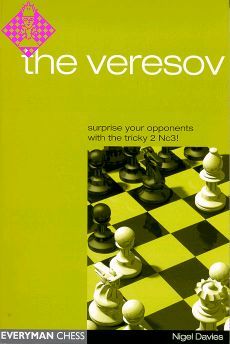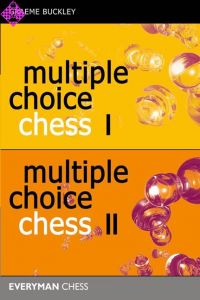Grandmaster Nigel Davies arms the reader with an all-in-one repertoire with the white
pieces, with the Veresov being the key component.
Nigel Davies is both an experienced Grandmaster and chess trainer and a former British Open Quickplay Champion.
Looking for a new opening?
The Veresov could be the one for you!
It's a surprisingly tricky system that, in the right hands, can be forged into a powerful attacking weapon.
White forgoes the normal queen's pawn opening ideas in favour of speedy development of the queenside pieces.
One advantage of this underrated line is that players with the black pieces are less likely to be familiar with all the subtleties here than in a more mainstream opening.
In this book, Grandmaster Nigel Davies arms the reader with a complete repertoire with the white pieces, with the Veresov being the central line. Davies delves into the secrets of the opening, explaining tactical and positional ideas, and highlighting the main plans for both sides.
An aggressive opening repertoire for White
Ideal for club and tournament players
Full explanation of the latest theory
The Veresov is a little played opening that is ideal for creative, aggressive players. As early as the second move White dares to be different by developing his knight to c3, and in so doing he contravenes the conventional wisdom about Queen's Pawn Openings which states that you must never obstruct your c-pawn. In fact White has a far more ambitious idea in mind; he wants to play for e2-e4.
The first Grandmaster to use this opening regularly in tournaments was Saviely Tartakower, but he was certainly not to be the last. Over the years many great players have enriched it with their games and ideas, including David Bronstein, Mikhail Tal, Boris Spassky, Bent Larsen, Lev Alburt and Kurt Richter. Yet it is Gavril Veresov who has contributed most to the theory of this opening, having played it week in and week out during his heyday in the 1950s and 60s. It is therefore fitting that it carries his name.
My first contact with the Veresov Opening came when I was a teenager and read a 1975 article in the magazine Chess. The author, Robert Bellin, wrote The Veresov is young and still molten, the crust of definite variations has yet to form. You can participate in the making of a new opening - if you try.' Being young and still molten myself, this sounded pretty good, and during my teenage years I played the Veresov regularly. It turned out that many other British amateurs had the same idea and this opening experienced an explosion of popularity in club and county games.
Since that time interest dwindled away with many of the Veresov specialists moving on to pastures new or disappearing from the chess scene altogether. Books have been written showing what are supposed to be effective answers for Black. Yet the Veresov is alive and well with the supposed 'antidotes' having been directed only at the traditional lines such as 3...Nbd7 4 f3 or 3...Nbd7 4 Nf3. Having examined the evidence I believe that 3...Nbd7 is by no means as good as some books have made out, with 4 Qd2!? (the ultra-violent approach), 4 Nf3 (Veresov's own favourite) and 4 e3 (my personal recommendation) being quite dangerous for Black.
It's not just in the 3...Nbd7 lines that I've found myself disagreeing with the experts; it seems to me that just about every variation of the Veresov has been misanalysed and/or misassessed. This presents a wonderful opportunity for practical players to surprise and outfox their opponents. I'm not in the least bit surprised that the Veresov has recently attracted the attention of the Swedish GM Jonny Hector and the up-and-coming Russian superstar Alexander Morozevich. Morozevich in particular seems to revel in the complex and original positions that the Veresov offers.
Because of the uncharted nature of the Veresov I haven't attempted to pin down the 'theory' and 'main lines' on the basis of a handful of obscure games. Instead I've written this book as an exploratory guide, saying what I drink is happening and what White's most promising plans are. Accordingly you will find a lot of my own suggestions and ideas which I've worked out in conjunction with Fritz 8 as an analysis partner. Fritz has been very good at checking tactics and some of the sharp variations, though I have frequently had to lead it by the hand in positions where strategy predominates or a material imbalance exists.
In order to provide a complete repertoire I have suggested an option for White against moves which transpose into other openings. Thus in Chapter 8 you'll find my suggested method of dealing with 3...e6, which normally transposes to a French Defence. In Chapter 9 I've given some lines against 1 d4 d5 2 Nc3 e6, 2...f5 and 2...c6, whilst in Chapter 10 I'll show you some things you can play against 1 d4 Nf6 2 Nc3 c5, 2...d6, 2...g6 and 2...e6. In these three chapters I've 'doctored' the early move order of games to show how they arise from a Veresov. My aim was to lend greater clarity to the material.
Learning a new opening should be a gradual process through which you get used to the positions before using them in serious games. The way I suggest you do this is by following the steps below:
1) Familiarise yourself with the basic pattern of play by playing through the games at speed. At this stage you should ignore the notes and sub-variations.
2) Play these lines in quick games at your local club or on the internet (www.freechess.org or www.chessclub.com).
3) Look up the lines that occurred in your games and cross-check your play against my own thoughts on these variations.
4) Repeat steps 2 and 3 for a month or two.
5) Study the book more carefully, working from cover to cover and making notes about any points of interest. Analyse the points of interest.
6) Adopt your new weapon in competitive games and matches.
7) Analyse your competitive games to establish what was happened and whether either side could improve.
I hope you enjoy this voyage through the uncharted waters of the Veresov Opening. I have certainly found this to be a fascinating subject to think and write about and after a 30 year hiatus I have started playing the Veresov again in a few games on the internet.
If you have any suggestions, comments or recommendations you might like to discuss them with me at the Tigerchess Yahoo Group. To enrol for this discussion group please go to my home page at http://www.tigerchess.com and enter your email address in the form provided. I look forward to meeting you and hearing about your Veresov triumphs!
Nigel Davies, Southport, July 2003, Introduction
pieces, with the Veresov being the key component.
Nigel Davies is both an experienced Grandmaster and chess trainer and a former British Open Quickplay Champion.
Looking for a new opening?
The Veresov could be the one for you!
It's a surprisingly tricky system that, in the right hands, can be forged into a powerful attacking weapon.
White forgoes the normal queen's pawn opening ideas in favour of speedy development of the queenside pieces.
One advantage of this underrated line is that players with the black pieces are less likely to be familiar with all the subtleties here than in a more mainstream opening.
In this book, Grandmaster Nigel Davies arms the reader with a complete repertoire with the white pieces, with the Veresov being the central line. Davies delves into the secrets of the opening, explaining tactical and positional ideas, and highlighting the main plans for both sides.
An aggressive opening repertoire for White
Ideal for club and tournament players
Full explanation of the latest theory
The Veresov is a little played opening that is ideal for creative, aggressive players. As early as the second move White dares to be different by developing his knight to c3, and in so doing he contravenes the conventional wisdom about Queen's Pawn Openings which states that you must never obstruct your c-pawn. In fact White has a far more ambitious idea in mind; he wants to play for e2-e4.
The first Grandmaster to use this opening regularly in tournaments was Saviely Tartakower, but he was certainly not to be the last. Over the years many great players have enriched it with their games and ideas, including David Bronstein, Mikhail Tal, Boris Spassky, Bent Larsen, Lev Alburt and Kurt Richter. Yet it is Gavril Veresov who has contributed most to the theory of this opening, having played it week in and week out during his heyday in the 1950s and 60s. It is therefore fitting that it carries his name.
My first contact with the Veresov Opening came when I was a teenager and read a 1975 article in the magazine Chess. The author, Robert Bellin, wrote The Veresov is young and still molten, the crust of definite variations has yet to form. You can participate in the making of a new opening - if you try.' Being young and still molten myself, this sounded pretty good, and during my teenage years I played the Veresov regularly. It turned out that many other British amateurs had the same idea and this opening experienced an explosion of popularity in club and county games.
Since that time interest dwindled away with many of the Veresov specialists moving on to pastures new or disappearing from the chess scene altogether. Books have been written showing what are supposed to be effective answers for Black. Yet the Veresov is alive and well with the supposed 'antidotes' having been directed only at the traditional lines such as 3...Nbd7 4 f3 or 3...Nbd7 4 Nf3. Having examined the evidence I believe that 3...Nbd7 is by no means as good as some books have made out, with 4 Qd2!? (the ultra-violent approach), 4 Nf3 (Veresov's own favourite) and 4 e3 (my personal recommendation) being quite dangerous for Black.
It's not just in the 3...Nbd7 lines that I've found myself disagreeing with the experts; it seems to me that just about every variation of the Veresov has been misanalysed and/or misassessed. This presents a wonderful opportunity for practical players to surprise and outfox their opponents. I'm not in the least bit surprised that the Veresov has recently attracted the attention of the Swedish GM Jonny Hector and the up-and-coming Russian superstar Alexander Morozevich. Morozevich in particular seems to revel in the complex and original positions that the Veresov offers.
Because of the uncharted nature of the Veresov I haven't attempted to pin down the 'theory' and 'main lines' on the basis of a handful of obscure games. Instead I've written this book as an exploratory guide, saying what I drink is happening and what White's most promising plans are. Accordingly you will find a lot of my own suggestions and ideas which I've worked out in conjunction with Fritz 8 as an analysis partner. Fritz has been very good at checking tactics and some of the sharp variations, though I have frequently had to lead it by the hand in positions where strategy predominates or a material imbalance exists.
In order to provide a complete repertoire I have suggested an option for White against moves which transpose into other openings. Thus in Chapter 8 you'll find my suggested method of dealing with 3...e6, which normally transposes to a French Defence. In Chapter 9 I've given some lines against 1 d4 d5 2 Nc3 e6, 2...f5 and 2...c6, whilst in Chapter 10 I'll show you some things you can play against 1 d4 Nf6 2 Nc3 c5, 2...d6, 2...g6 and 2...e6. In these three chapters I've 'doctored' the early move order of games to show how they arise from a Veresov. My aim was to lend greater clarity to the material.
Learning a new opening should be a gradual process through which you get used to the positions before using them in serious games. The way I suggest you do this is by following the steps below:
1) Familiarise yourself with the basic pattern of play by playing through the games at speed. At this stage you should ignore the notes and sub-variations.
2) Play these lines in quick games at your local club or on the internet (www.freechess.org or www.chessclub.com).
3) Look up the lines that occurred in your games and cross-check your play against my own thoughts on these variations.
4) Repeat steps 2 and 3 for a month or two.
5) Study the book more carefully, working from cover to cover and making notes about any points of interest. Analyse the points of interest.
6) Adopt your new weapon in competitive games and matches.
7) Analyse your competitive games to establish what was happened and whether either side could improve.
I hope you enjoy this voyage through the uncharted waters of the Veresov Opening. I have certainly found this to be a fascinating subject to think and write about and after a 30 year hiatus I have started playing the Veresov again in a few games on the internet.
If you have any suggestions, comments or recommendations you might like to discuss them with me at the Tigerchess Yahoo Group. To enrol for this discussion group please go to my home page at http://www.tigerchess.com and enter your email address in the form provided. I look forward to meeting you and hearing about your Veresov triumphs!
Nigel Davies, Southport, July 2003, Introduction
Grandmaster Nigel Davies arms the reader with an all-in-one repertoire with the white
pieces, with the Veresov being the key component.
Nigel Davies is both an experienced Grandmaster and chess trainer and a former British Open Quickplay Champion.
Looking for a new opening?
The Veresov could be the one for you!
It's a surprisingly tricky system that, in the right hands, can be forged into a powerful attacking weapon.
White forgoes the normal queen's pawn opening ideas in favour of speedy development of the queenside pieces.
One advantage of this underrated line is that players with the black pieces are less likely to be familiar with all the subtleties here than in a more mainstream opening.
In this book, Grandmaster Nigel Davies arms the reader with a complete repertoire with the white pieces, with the Veresov being the central line. Davies delves into the secrets of the opening, explaining tactical and positional ideas, and highlighting the main plans for both sides.
An aggressive opening repertoire for White
Ideal for club and tournament players
Full explanation of the latest theory
The Veresov is a little played opening that is ideal for creative, aggressive players. As early as the second move White dares to be different by developing his knight to c3, and in so doing he contravenes the conventional wisdom about Queen's Pawn Openings which states that you must never obstruct your c-pawn. In fact White has a far more ambitious idea in mind; he wants to play for e2-e4.
The first Grandmaster to use this opening regularly in tournaments was Saviely Tartakower, but he was certainly not to be the last. Over the years many great players have enriched it with their games and ideas, including David Bronstein, Mikhail Tal, Boris Spassky, Bent Larsen, Lev Alburt and Kurt Richter. Yet it is Gavril Veresov who has contributed most to the theory of this opening, having played it week in and week out during his heyday in the 1950s and 60s. It is therefore fitting that it carries his name.
My first contact with the Veresov Opening came when I was a teenager and read a 1975 article in the magazine Chess. The author, Robert Bellin, wrote The Veresov is young and still molten, the crust of definite variations has yet to form. You can participate in the making of a new opening - if you try.' Being young and still molten myself, this sounded pretty good, and during my teenage years I played the Veresov regularly. It turned out that many other British amateurs had the same idea and this opening experienced an explosion of popularity in club and county games.
Since that time interest dwindled away with many of the Veresov specialists moving on to pastures new or disappearing from the chess scene altogether. Books have been written showing what are supposed to be effective answers for Black. Yet the Veresov is alive and well with the supposed 'antidotes' having been directed only at the traditional lines such as 3...Nbd7 4 f3 or 3...Nbd7 4 Nf3. Having examined the evidence I believe that 3...Nbd7 is by no means as good as some books have made out, with 4 Qd2!? (the ultra-violent approach), 4 Nf3 (Veresov's own favourite) and 4 e3 (my personal recommendation) being quite dangerous for Black.
It's not just in the 3...Nbd7 lines that I've found myself disagreeing with the experts; it seems to me that just about every variation of the Veresov has been misanalysed and/or misassessed. This presents a wonderful opportunity for practical players to surprise and outfox their opponents. I'm not in the least bit surprised that the Veresov has recently attracted the attention of the Swedish GM Jonny Hector and the up-and-coming Russian superstar Alexander Morozevich. Morozevich in particular seems to revel in the complex and original positions that the Veresov offers.
Because of the uncharted nature of the Veresov I haven't attempted to pin down the 'theory' and 'main lines' on the basis of a handful of obscure games. Instead I've written this book as an exploratory guide, saying what I drink is happening and what White's most promising plans are. Accordingly you will find a lot of my own suggestions and ideas which I've worked out in conjunction with Fritz 8 as an analysis partner. Fritz has been very good at checking tactics and some of the sharp variations, though I have frequently had to lead it by the hand in positions where strategy predominates or a material imbalance exists.
In order to provide a complete repertoire I have suggested an option for White against moves which transpose into other openings. Thus in Chapter 8 you'll find my suggested method of dealing with 3...e6, which normally transposes to a French Defence. In Chapter 9 I've given some lines against 1 d4 d5 2 Nc3 e6, 2...f5 and 2...c6, whilst in Chapter 10 I'll show you some things you can play against 1 d4 Nf6 2 Nc3 c5, 2...d6, 2...g6 and 2...e6. In these three chapters I've 'doctored' the early move order of games to show how they arise from a Veresov. My aim was to lend greater clarity to the material.
Learning a new opening should be a gradual process through which you get used to the positions before using them in serious games. The way I suggest you do this is by following the steps below:
1) Familiarise yourself with the basic pattern of play by playing through the games at speed. At this stage you should ignore the notes and sub-variations.
2) Play these lines in quick games at your local club or on the internet (www.freechess.org or www.chessclub.com).
3) Look up the lines that occurred in your games and cross-check your play against my own thoughts on these variations.
4) Repeat steps 2 and 3 for a month or two.
5) Study the book more carefully, working from cover to cover and making notes about any points of interest. Analyse the points of interest.
6) Adopt your new weapon in competitive games and matches.
7) Analyse your competitive games to establish what was happened and whether either side could improve.
I hope you enjoy this voyage through the uncharted waters of the Veresov Opening. I have certainly found this to be a fascinating subject to think and write about and after a 30 year hiatus I have started playing the Veresov again in a few games on the internet.
If you have any suggestions, comments or recommendations you might like to discuss them with me at the Tigerchess Yahoo Group. To enrol for this discussion group please go to my home page at http://www.tigerchess.com and enter your email address in the form provided. I look forward to meeting you and hearing about your Veresov triumphs!
Nigel Davies, Southport, July 2003, Introduction
pieces, with the Veresov being the key component.
Nigel Davies is both an experienced Grandmaster and chess trainer and a former British Open Quickplay Champion.
Looking for a new opening?
The Veresov could be the one for you!
It's a surprisingly tricky system that, in the right hands, can be forged into a powerful attacking weapon.
White forgoes the normal queen's pawn opening ideas in favour of speedy development of the queenside pieces.
One advantage of this underrated line is that players with the black pieces are less likely to be familiar with all the subtleties here than in a more mainstream opening.
In this book, Grandmaster Nigel Davies arms the reader with a complete repertoire with the white pieces, with the Veresov being the central line. Davies delves into the secrets of the opening, explaining tactical and positional ideas, and highlighting the main plans for both sides.
An aggressive opening repertoire for White
Ideal for club and tournament players
Full explanation of the latest theory
The Veresov is a little played opening that is ideal for creative, aggressive players. As early as the second move White dares to be different by developing his knight to c3, and in so doing he contravenes the conventional wisdom about Queen's Pawn Openings which states that you must never obstruct your c-pawn. In fact White has a far more ambitious idea in mind; he wants to play for e2-e4.
The first Grandmaster to use this opening regularly in tournaments was Saviely Tartakower, but he was certainly not to be the last. Over the years many great players have enriched it with their games and ideas, including David Bronstein, Mikhail Tal, Boris Spassky, Bent Larsen, Lev Alburt and Kurt Richter. Yet it is Gavril Veresov who has contributed most to the theory of this opening, having played it week in and week out during his heyday in the 1950s and 60s. It is therefore fitting that it carries his name.
My first contact with the Veresov Opening came when I was a teenager and read a 1975 article in the magazine Chess. The author, Robert Bellin, wrote The Veresov is young and still molten, the crust of definite variations has yet to form. You can participate in the making of a new opening - if you try.' Being young and still molten myself, this sounded pretty good, and during my teenage years I played the Veresov regularly. It turned out that many other British amateurs had the same idea and this opening experienced an explosion of popularity in club and county games.
Since that time interest dwindled away with many of the Veresov specialists moving on to pastures new or disappearing from the chess scene altogether. Books have been written showing what are supposed to be effective answers for Black. Yet the Veresov is alive and well with the supposed 'antidotes' having been directed only at the traditional lines such as 3...Nbd7 4 f3 or 3...Nbd7 4 Nf3. Having examined the evidence I believe that 3...Nbd7 is by no means as good as some books have made out, with 4 Qd2!? (the ultra-violent approach), 4 Nf3 (Veresov's own favourite) and 4 e3 (my personal recommendation) being quite dangerous for Black.
It's not just in the 3...Nbd7 lines that I've found myself disagreeing with the experts; it seems to me that just about every variation of the Veresov has been misanalysed and/or misassessed. This presents a wonderful opportunity for practical players to surprise and outfox their opponents. I'm not in the least bit surprised that the Veresov has recently attracted the attention of the Swedish GM Jonny Hector and the up-and-coming Russian superstar Alexander Morozevich. Morozevich in particular seems to revel in the complex and original positions that the Veresov offers.
Because of the uncharted nature of the Veresov I haven't attempted to pin down the 'theory' and 'main lines' on the basis of a handful of obscure games. Instead I've written this book as an exploratory guide, saying what I drink is happening and what White's most promising plans are. Accordingly you will find a lot of my own suggestions and ideas which I've worked out in conjunction with Fritz 8 as an analysis partner. Fritz has been very good at checking tactics and some of the sharp variations, though I have frequently had to lead it by the hand in positions where strategy predominates or a material imbalance exists.
In order to provide a complete repertoire I have suggested an option for White against moves which transpose into other openings. Thus in Chapter 8 you'll find my suggested method of dealing with 3...e6, which normally transposes to a French Defence. In Chapter 9 I've given some lines against 1 d4 d5 2 Nc3 e6, 2...f5 and 2...c6, whilst in Chapter 10 I'll show you some things you can play against 1 d4 Nf6 2 Nc3 c5, 2...d6, 2...g6 and 2...e6. In these three chapters I've 'doctored' the early move order of games to show how they arise from a Veresov. My aim was to lend greater clarity to the material.
Learning a new opening should be a gradual process through which you get used to the positions before using them in serious games. The way I suggest you do this is by following the steps below:
1) Familiarise yourself with the basic pattern of play by playing through the games at speed. At this stage you should ignore the notes and sub-variations.
2) Play these lines in quick games at your local club or on the internet (www.freechess.org or www.chessclub.com).
3) Look up the lines that occurred in your games and cross-check your play against my own thoughts on these variations.
4) Repeat steps 2 and 3 for a month or two.
5) Study the book more carefully, working from cover to cover and making notes about any points of interest. Analyse the points of interest.
6) Adopt your new weapon in competitive games and matches.
7) Analyse your competitive games to establish what was happened and whether either side could improve.
I hope you enjoy this voyage through the uncharted waters of the Veresov Opening. I have certainly found this to be a fascinating subject to think and write about and after a 30 year hiatus I have started playing the Veresov again in a few games on the internet.
If you have any suggestions, comments or recommendations you might like to discuss them with me at the Tigerchess Yahoo Group. To enrol for this discussion group please go to my home page at http://www.tigerchess.com and enter your email address in the form provided. I look forward to meeting you and hearing about your Veresov triumphs!
Nigel Davies, Southport, July 2003, Introduction
| EAN | 9781857443356 |
|---|---|
| Weight | 260 g |
| Manufacturer | Everyman |
| Width | 15.6 cm |
| Height | 23.4 cm |
| Medium | Book |
| Year of Publication | 2003 |
| Author | Nigel Davies |
| Language | English |
| Edition | 1 |
| ISBN-10 | 1857443357 |
| ISBN-13 | 9781857443356 |
| Pages | 144 |
| Binding | paperback |
| Name | Everyman (former Cadogan) |
|---|---|
| Adresse | 10 Northburgh Street London EC1V 0AT Großbritannien |
| dcaddelman@yahoo.com |
Verantwortlicher Importeuer:
| Name | Schachversand Niggemann |
|---|---|
| Adresse | Schadowstraße 5 48163 Münster Deutschland |
| info@schachversand.de | |
| Internet | www.schachversand.de |
004 Bibliography
005 Introduction
1 d4 Nf6 2 Nc3 d5 3 Bg5
007 1 3...Nbd7 4 f3
026 2 3...Nbd7 4 Qd2 and 4 Nf3
043 3 3...Nbd7 4 Nf3, 4 e3 and Others
062 4 3...c5
076 5 3...c6
089 6 3...Bf5
105 7 3...h6, 3...Nc6, 3...g6 and Others
118 8 3...e6 (including French Transpositions)
Other Variations
131 9 1...d5 2 Nc3 e6, 2...f5 & Others
144 10 1...Nf6 2 Nc3 c5, 2...d6, 2...g6 and 2...e6
159 Index of Complete Games
Index of Complete Games
011 Adam-Muller, Berlin 1989
022 Alburt-Kapengut, USSR Ch., Baku 1972
036 Alburt-Zilberstein, USSR Ch., Baku 1972
123 Almasi-Andersson, Ubeda 1997
154 Anand-Karpov, F7DE World Ch., Lausanne 1998
089 Bairamov-Smagin, USSR 1982
109 Bellin-Penrose, British Ch., Clacton 1974
016 Bellon Lopez-Keene, Dortmund 1980
113 Bellon Lopez-Spassky, Linares 1981
040 Ben Menachem-Boric, European Cup, Eupen 1997
100 Bochkarev-Vinokurov, Voronezh Open 2001
058 Brandner-Miniboeck, St Poelten 2002
059 Bricard-Todorov, St Affrique Open 2000
101 Ciocaltea-Tabor, Baja 1971
023 Czerniak-Hamann, Buenos Aires 1947
149 De la Villa-Glavina Rossi, Zaragoza Open 1995
028 De Souza Haro-Vescovi, Sao Paulo Zonal 2001
034 Donev-Zlatilov, Elenite Open 1986
056 Ermenkov-Grivas, Sofia 1986
152 Fahnenschmidt-Eis, Rheda-Wiedenbrueck 2001
148 Grimm-Tseitlin.Mi, Passau 1998
097 Gufeld-Ujtumen, Tbilisi 1971
079 Gurgenidze-Stein, Kislovodsk 1972
156 Hall-De Firmian, Ma/mo 1999
128 Hector-Berg, Solett Open, Skelleftea 2001
141 Hort-Polgar.So, Amsterdam 2001
069 Hort-Van der Wiel, Amsterdam 1982
092 Jagielsky-Pytlakowski, Poland 2000
093 Khachian-Strikovic, Candas Open 1996
136 Khalifman-Lerner, Kujbyshev 1986
151 Klinger-Maxion, Bad Worishofen 1990
080 Kohlhage-Langheinrich, Schloss Open, Werther 2000
015 Kuijf.H-Hoeksema, The Netherlands 1987
055 Kupreichik-Gutman, USSR 1976
096 Kupreichik-Westerinen, Dortmund 1975
127 Lobron-Murey, Randers Zonal 1982
134 Macieja-Bartel, Polish Ch., Warsaw 2002
081 Markovic-Cvitan, Bosnian Team Ch., Neum 2002
114 Maryasin-Manor, Israeli Team Ch. 2002
094 Maryasin-Tyomkin, Israeli Open Ch., Tel Aviv 1999
053 Mestrovic-Deze, Yugoslavia 1969
150 Mestrovic-Medic, Pula Open 1996
070 Mestrovic-Zivkovic, Croatia Cup, Pula 1997
067 Mihajlovskij-Gershon, World U16 Ch., Menorca 1996
145 Miladinovic-Gustafsson, Germany-Greece Match, Fuerth 2002
065 Miladinovic-Smagin, Montreal 2000
043 Miles-Andersson, London Phillips & Drew 1982
106 Miles-Spassov, Surakarta-Denpasar 1982
038 Miles-Watson.W, British Ch., Torquay 1982
010 Morozevich-Lazarev, Alushta 1993
083 Morozevich-Malaniuk, Alushta 1994
120 Norman-O'Hanlon, Hastings 1921/22
047 Otero-Camacho, Cuba (1st matchgame) 1997
077 Pasman-Kr.Georgiev, EU U20 Ch., Groningen 1977
013 Rajna-Vogt, Leipzig 1976
018 Ranniku-Bulinova, USSR Women's Ch., Sochi 1971
026 Reprintsev-Evelev, Geller Memorial, Moscow 1999
107 Reprintsev-Kachar, Geller Memorial, Moscow 1999
050 Reynolds-Nunn, London 1987
076 Richter-Rogmann, Berlin 1937
139 Romero Holmes-Vallejo. Pons, Elgoibar 1997
031 Rossetto-Darga, Lugano Olympiad 1968
008 Rossetto-Gufeld, Camaguey 1974
072 Sagalchik-Ariel, USA Ch., Seattle 2002
116 Sammalvuo-Ronnman, Vantaa 1991
121 Shirov-Akopian, European Club Ch., Halkidiki 2002
125 Shirov-Topalov, Sarajevo 2000
030 Smirnov-Yagupov, Alushta 2002
032 Smyslov-Geller, USSR Ch., Leningrad 1977
132 Sokolov.I-Illescas Cordoba, Hoogovens, Wijk aan Zee 1997
138 Sokolov.I-Nikolic.Pr, Dutch Ch., Rotterdam 1998
111 Spassky-Korchnoi, Candidates Match, Belgrade 1977
071 Speelman-Saltaev, Hastings Premier 1998/99
084 Stryjecki-Vokac, Czech Extra League 2001
131 Taeger-Tessars, Bundesliga 1983/84
118 Tartakower-Lilienthal, Paris (match) 1933
086 Veresov-Krogius, USSR Team Ch. 1953
062 Veresov-Shustef, USSR 1974
019 Wockenfuss-Timman, Bad Lauterberg 1977
052 Yermolinsky-Kaidanov, New York 1993
005 Introduction
1 d4 Nf6 2 Nc3 d5 3 Bg5
007 1 3...Nbd7 4 f3
026 2 3...Nbd7 4 Qd2 and 4 Nf3
043 3 3...Nbd7 4 Nf3, 4 e3 and Others
062 4 3...c5
076 5 3...c6
089 6 3...Bf5
105 7 3...h6, 3...Nc6, 3...g6 and Others
118 8 3...e6 (including French Transpositions)
Other Variations
131 9 1...d5 2 Nc3 e6, 2...f5 & Others
144 10 1...Nf6 2 Nc3 c5, 2...d6, 2...g6 and 2...e6
159 Index of Complete Games
Index of Complete Games
011 Adam-Muller, Berlin 1989
022 Alburt-Kapengut, USSR Ch., Baku 1972
036 Alburt-Zilberstein, USSR Ch., Baku 1972
123 Almasi-Andersson, Ubeda 1997
154 Anand-Karpov, F7DE World Ch., Lausanne 1998
089 Bairamov-Smagin, USSR 1982
109 Bellin-Penrose, British Ch., Clacton 1974
016 Bellon Lopez-Keene, Dortmund 1980
113 Bellon Lopez-Spassky, Linares 1981
040 Ben Menachem-Boric, European Cup, Eupen 1997
100 Bochkarev-Vinokurov, Voronezh Open 2001
058 Brandner-Miniboeck, St Poelten 2002
059 Bricard-Todorov, St Affrique Open 2000
101 Ciocaltea-Tabor, Baja 1971
023 Czerniak-Hamann, Buenos Aires 1947
149 De la Villa-Glavina Rossi, Zaragoza Open 1995
028 De Souza Haro-Vescovi, Sao Paulo Zonal 2001
034 Donev-Zlatilov, Elenite Open 1986
056 Ermenkov-Grivas, Sofia 1986
152 Fahnenschmidt-Eis, Rheda-Wiedenbrueck 2001
148 Grimm-Tseitlin.Mi, Passau 1998
097 Gufeld-Ujtumen, Tbilisi 1971
079 Gurgenidze-Stein, Kislovodsk 1972
156 Hall-De Firmian, Ma/mo 1999
128 Hector-Berg, Solett Open, Skelleftea 2001
141 Hort-Polgar.So, Amsterdam 2001
069 Hort-Van der Wiel, Amsterdam 1982
092 Jagielsky-Pytlakowski, Poland 2000
093 Khachian-Strikovic, Candas Open 1996
136 Khalifman-Lerner, Kujbyshev 1986
151 Klinger-Maxion, Bad Worishofen 1990
080 Kohlhage-Langheinrich, Schloss Open, Werther 2000
015 Kuijf.H-Hoeksema, The Netherlands 1987
055 Kupreichik-Gutman, USSR 1976
096 Kupreichik-Westerinen, Dortmund 1975
127 Lobron-Murey, Randers Zonal 1982
134 Macieja-Bartel, Polish Ch., Warsaw 2002
081 Markovic-Cvitan, Bosnian Team Ch., Neum 2002
114 Maryasin-Manor, Israeli Team Ch. 2002
094 Maryasin-Tyomkin, Israeli Open Ch., Tel Aviv 1999
053 Mestrovic-Deze, Yugoslavia 1969
150 Mestrovic-Medic, Pula Open 1996
070 Mestrovic-Zivkovic, Croatia Cup, Pula 1997
067 Mihajlovskij-Gershon, World U16 Ch., Menorca 1996
145 Miladinovic-Gustafsson, Germany-Greece Match, Fuerth 2002
065 Miladinovic-Smagin, Montreal 2000
043 Miles-Andersson, London Phillips & Drew 1982
106 Miles-Spassov, Surakarta-Denpasar 1982
038 Miles-Watson.W, British Ch., Torquay 1982
010 Morozevich-Lazarev, Alushta 1993
083 Morozevich-Malaniuk, Alushta 1994
120 Norman-O'Hanlon, Hastings 1921/22
047 Otero-Camacho, Cuba (1st matchgame) 1997
077 Pasman-Kr.Georgiev, EU U20 Ch., Groningen 1977
013 Rajna-Vogt, Leipzig 1976
018 Ranniku-Bulinova, USSR Women's Ch., Sochi 1971
026 Reprintsev-Evelev, Geller Memorial, Moscow 1999
107 Reprintsev-Kachar, Geller Memorial, Moscow 1999
050 Reynolds-Nunn, London 1987
076 Richter-Rogmann, Berlin 1937
139 Romero Holmes-Vallejo. Pons, Elgoibar 1997
031 Rossetto-Darga, Lugano Olympiad 1968
008 Rossetto-Gufeld, Camaguey 1974
072 Sagalchik-Ariel, USA Ch., Seattle 2002
116 Sammalvuo-Ronnman, Vantaa 1991
121 Shirov-Akopian, European Club Ch., Halkidiki 2002
125 Shirov-Topalov, Sarajevo 2000
030 Smirnov-Yagupov, Alushta 2002
032 Smyslov-Geller, USSR Ch., Leningrad 1977
132 Sokolov.I-Illescas Cordoba, Hoogovens, Wijk aan Zee 1997
138 Sokolov.I-Nikolic.Pr, Dutch Ch., Rotterdam 1998
111 Spassky-Korchnoi, Candidates Match, Belgrade 1977
071 Speelman-Saltaev, Hastings Premier 1998/99
084 Stryjecki-Vokac, Czech Extra League 2001
131 Taeger-Tessars, Bundesliga 1983/84
118 Tartakower-Lilienthal, Paris (match) 1933
086 Veresov-Krogius, USSR Team Ch. 1953
062 Veresov-Shustef, USSR 1974
019 Wockenfuss-Timman, Bad Lauterberg 1977
052 Yermolinsky-Kaidanov, New York 1993
Als ich selbst vor mehreren Jahren nach ziemlich langer Anwendung Veresov aufgab, war ich überzeugt, dass (trotz zeitweise recht guter praktischer Erfolge) gerade die anspruchsvollen und vermeintlich kritischen Varianten nahezu alle aus weißer Sicht unergiebig, wenn nicht gar schlecht sind. Für eine Wiederbelebung der Eröffnung schien nicht nur die Reparatur von ein oder zwei konkreten Schwachstellen, sondern eine Rundum-Erneuerung nötig. Nun tritt das Davies-Buch in der Einleitung mit dem Anspruch auf, Hoffnung zu bringen: „Es ist nicht nur in den 3...Sbd7-Varianten, wo ich mich nicht in Übereinstimmung mit den Experten befand. Mir scheint, dass so ungefähr jede Variante im Veresov falsch analysiert und/oder falsch eingeschätzt wurde..." Hat der Autor (immerhin langjähriger GM und Schachtrainer) nun aber selbst die richtigen Lösungen anzubieten? Zunächst stellt man fest, dass sich die zitierte Meinung über die herkömmliche Theorie offenbar auch auf andere Eröffnungen erstreckt. Vor allem bei der wohl wichtigsten Überleitung (das Buch ist als Gesamt-Repertoire für Weiß aufgebaut) liegt Davies' Empfehlung genau so weit abseits der üblichen Wege. Im Französisch (via 1.d4 Sf6 2.Sc3 d5 3. Lg5 e6) soll man zuerst 4. Sf3 spielen, um wichtige schwarze Optionen zu umgehen - aus praktischer Sicht ein sehr löblicher Tipp, der freilich dazu führt, dass man nach dem Hauptzug 4...Le7 die Variante 5. Lxf6 Lxf6 6. e4 spielen muss. Die gilt seit Urzeiten als harmlos oder gar minderwertig, wurde deswegen freilich auch seit Urzeiten wohl nie mehr genau untersucht und starb in der Meisterpraxis nahezu aus - ist aber laut Davies für Weiß chancenreich. Angesichts solch auffälliger Kontraste und der Tatsache, dass nicht selten die nach Ansicht des Autors beste Spielweise nur in einer ungeprüften Empfehlung besteht, stellt sich natürlich die Frage: Was ist davon objektiv zu halten? So weit ich meine eigene Veresov-Erfahrung heranziehen kann, ist mein Eindruck gemischt. Manche Ideen könnten tatsächlich neue Perspektiven eröffnen, sehr wenig beachtet blieb bisher z.B. die Stonewall-Behandlung (e3/f4) mit bereits entwickeltem Problemläufer, die Davies speziell gegen 3...Sbd7 empfiehlt und mit der in diverser Form schon vor Jahrzehnten der deutsche Hauptspezialist dieses Systems, der legendäre Kurt Richter experimentiert hat. An einigen Stellen drängt sich aber auch der Verdacht auf, dass manches doch etwas leichthändig aufs Papier geworfen wurde; z.B. in der nicht unwichtigen Variante 3...Lf5 4. f3 Sbd7 5. Sxd5 Sxd5 6. e4 h6 7. Lh4 wird der Zug 7...S7b6 nur in einem Zwei-Zeilen-Kommentar als „interessant" erwähnt, während ihn schon das 20 Jahre alte Buch von Bellin praktisch für die Widerlegung des weißen Spiels hält (wozu Davies keine Verbesserung parat hat). Abschließend noch ein paar Hinweise zu Umfang und Gestalt des erwähnten Gesamt-Repertoires, denn allein schon nach 1.d4 Sf6 2.Sc3 kann Schwarz den Übergang in verschiedene andere Eröffnungen versuchen, umso mehr wenn Weiß den Zug 2.Sc3 auch nach 1.d4 d5 anwenden will. Ein Teil dieser Versuche wird ebenfalls mit unorthodoxen Nebenvarianten abgedeckt; vor allem in drei Fällen sind aber echte Überleitungen vorgesehen. Nach 1.d4 d5 2.Sc3 führt 2...f5 unvermeidlich zu einer Holländisch-Variante (die aber mit fünf Partien ausführlich behandelt wird), und nach 1.d4 Sf6 2. Sc3 wird auf 2...c5 bzw. 2...e6 jeweils 3. Lg5 empfohlen; diese Stellungen findet man sonst gewöhnlich im Trompowsky-Revier. In dieser Richtung dürfte eigene Nacharbeit sinnvoll sein, zumal die letzte Zugfolge zu einer echten Hauptvariante führen kann (2...e6 3. Lg5 h6 4. Lxf6 Dxf6 5.e4), die für meinen Geschmack hier zu knapp abgehandelt wird.
FM Gerd Treppner, Rochade Europa 09/2003
FM Gerd Treppner, Rochade Europa 09/2003
More from Everyman
-
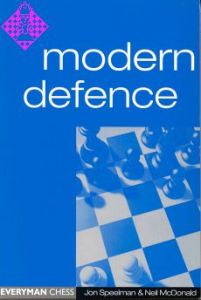 Modern Defence€17.50
Modern Defence€17.50 -
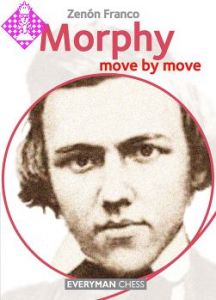 Morphy: Move by Move€24.50
Morphy: Move by Move€24.50 -
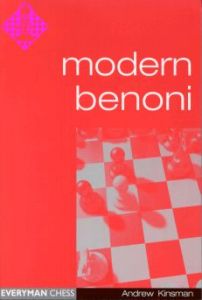 Modern Benoni€18.50
Modern Benoni€18.50 -
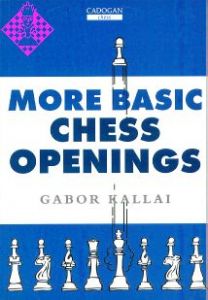 More Basic Chess Openings€17.95
More Basic Chess Openings€17.95 -
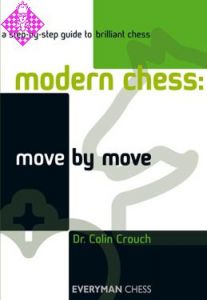 Modern Chess: Move by Move€24.95
Modern Chess: Move by Move€24.95 - More from Everyman

